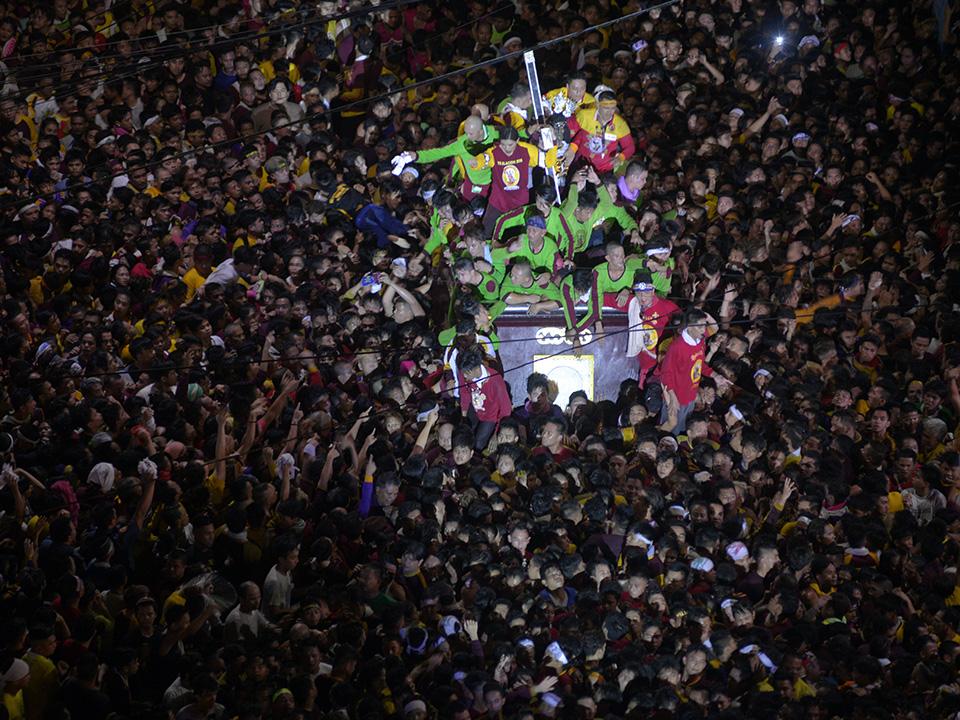15 things you need to know about the Black Nazarene and Traslacion

The Feast of the Black Nazarene is one of the most significant events for Filipino Catholics. Throngs of devotees are expected to gather during the traditional Traslacion on January 9, 2024, especially after a three-year hiatus due to the COVID-19 pandemic.
Traslacion is one of the activities in the celebration of the Feast of the Black Nazarene; it is a procession from Quirino Grandstand to Quiapo Church of the 400-year-old black image of Jesus Christ.
With the return of the traditional procession, aside from the regular Filipino devotees, a new generation of faithful are also expected to add up the crowd.
As most of the devotees are getting ready for the Traslacion, here are some facts that you must know:
- The Black Nazarene, also known as the Nuestro Padre Jesus Nazareno, arrived in Manila from Mexico in 1606. It was placed in the Church of St. John the Baptist in Bagumbayan, now Luneta or Rizal Park. It was transferred to Intramuros in 1608.
- An unknown Mexican artist painted the image of the semi-kneeling Christ a dark brown color, similar to his own skin. The image was entrusted to a Recollect parish and brought to Manila from Mexico.
- The image was said to be damaged and became darker when the galleon carrying it caught fire. But in a 2015 GMA News Online interview, Loyola School of Theology lecturer Msgr. Sabino Vengco, Jr. said the wood used to make the image, mesquite, was by itself already dark-colored.
- Traslacion is the high point of the devotion, which commemorates the transfer of the image from Intramuros to Quiapo Church in 1700s, not the feast day of the parish. The feast day of Quiapo Church, or the Parish of Saint John the Baptist, is June 24.
- Señor Nazareno is placed on an andas (carriage), which has wheels but not a motor, and is pulled by 'mamamasan' holding on to two 50-meter-long abaca ropes. The original andas was made of silver until it sustained damage in 1976.
- A gunshot in the late 1990s damaged the Black Nazarene's left cheek.
- The image survived fires that destroyed Quiapo Church in 1791 and 1929; great earthquakes in 1645 and 1863; and the World War II bombing of Manila in 1945.
- The longest procession in the history of the image was in 2012, which took more than 22 hours.
- Devotees who participate in the procession are barefoot as a sign of humility. They also endure hours of physical discomfort to get close to and touch the statue as part of their sacrifice. They believe the image is miraculous as it has survived several disasters, including fires and earthquakes.
- In 2020, the last Traslacion before the pandemic gathered more than 3 million devotees and lasted 16 hours.
- In 2021, instead of holding Traslacion, the image was brought to several places in the Archdiocese of Manila and other neighboring dioceses. The traditional "pahalik" or kissing on the image was also replaced by "patanaw" or "viewing." This was done again in 2022.
- For this year's celebration of the Feast of the Black Nazarene, the Church will use the same route for the grand procession in 2020.
- The new andas that will carry the image include lights, sound system, and CCTV. Meanwhile, the image will be covered with a laminated glass case for protection.
- Quiapo Church will still allow devotees to throw their handkerchiefs and towels to rub them on the Black Nazarene image. However, organizers prohibited devotees from climbing the andas to prevent blocking the view of the Black Nazarene image.
- January 9, 2024 is a special non-working holiday in Manila to give way for the Traslacion.
—Sherylin Untalan with GMA News Research/AOL, GMA Integrated News




